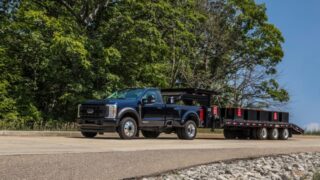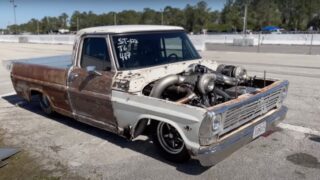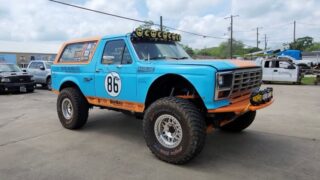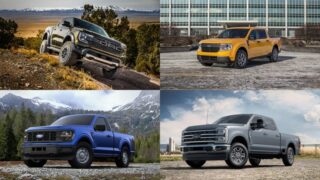Ford Explorer and the Tire Replacement Program: Myths & Facts
Myths & Facts About the Explorer
Myth: SUVs are unsafe because they roll over. SUV owners
would be better off driving cars.
Fact: That’s false. Advances in safety
technology have made all types of passenger vehicles safer than the
vehicles on the road a generation ago. And Ford’s analysis of
federal and state government safety data shows that, overall, SUVs
are even safer than passenger cars. That’s because SUVs are
involved in fewer accidents – SUV drivers often have better lines of
sight and SUVs are more visible to other drivers. Also, SUV
occupants are often better protected when they are involved in
collisions.
Although SUVs are involved in more rollover crashes than
passenger cars, there is a greater risk of fatality in a passenger
car in frontal, side and rear impacts. As a result, SUVs are safer
overall.
SUVs do handle differently. That is a key reason that the
different handling characteristics are printed on a label appearing
on the visor of every SUV all automakers build.
Leading edge safety technology available later this year on the
2002 Ford Explorer – including AdvanceTracTM electronic stability
control and Ford’s new Safety CanopyTM – will further reduce the
risk of a rollover and serious injury or death if a rollover
accident occurs. But a buckled safety belt is still the best and
primary line of defense for any adult occupant in a serious
accident. Children should of course be in the proper restraint
system (child seat, booster seat, etc.) until they are large enough
to use adult safety belts.
Myth: The Ford Explorer is more prone to roll over than
other SUVs.
Fact: Not true. Ford’s analysis of safety data
from the U.S. Department of Transportation confirms that over the
past 10 years Explorer consistently ranks among the safest vehicles
in its class. The fatality rate for passenger cars is 1.5 per 100
million miles of vehicle travel. The rate for compact SUVs is lower
– 1.3. And the Explorer is even lower at 1.1.
Focusing on rollover accidents alone, the Explorer is safer than
competitive SUVs. Ford analysis of government safety data reveals
that the Explorer line is involved in 19 percent fewer fatal
rollovers than other similar SUVs. And, state safety data, which
covers fatal and non-fatal rollovers, show that Explorers are
involved in 16 percent fewer rollovers than competitive SUVs.
Myth: Ford launched this tire replacement effort to shift
blame away from the Explorer. Something is wrong with the Explorer,
but Ford wants people to think it’s just a tire issue.
Fact: Not true. Ford Motor Company is replacing
these tires because its number one priority is to ensure the safety
of our customers and their families. Ford’s concern is the
Wilderness AT tire. The facts are as follows:
First, Ford fitted both Firestone tires and Goodyear tires on
Explorers beginning in 1995 and through the 1997 model year. And
the difference in performance is dramatic. For the roughly 3
million Firestone tires equipped on about 500,000 Explorers,
Firestone’s own claims database shows that there have been
1,183 claims of tread separation. For the 3 million Goodyear
tires on another 500,000 Explorers (that have traveled more than 25
billion miles), there have been only two minor claims
of tread separation according to claims information supplied by
Goodyear. The performance on the Firestone AT tires on Explorer is
600 times worse than Goodyear tires on Explorer. This remains
the only apples-to-apples comparison in this issue. If the
vehicle was the issue, or at the very least a contributing factor,
the tread separations between the Firestone and Goodyear tires would
be in the same ballpark. They are not even close. That’s why Ford
is replacing the Firestone Wilderness AT tires.
Second, when Ford engineers tested the Wilderness AT tires over
the past nine months, they found that the tires were more sensitive
to stresses and consistently failed at higher rates, at lower speeds
and lighter loads than other tires tested, including the Goodyear
tires used on Explorer.
Third, the failure rates of Firestone Wilderness AT tires differ
dramatically based on the plant in which they were made. If the
vehicle were the cause of these separations, the tire plant location
would not make a difference in rate of tread separations reported.
Finally, Firestone CEO John Lampe testified last year before
Congress under oath and said the following: “We made some bad tires
and we take full responsibility for those.” When a Senator asked,
“Are bad tires equated to be tires that have defects of some kind,”
Mr. Lampe responded, “Yes, sir.”
Myth: The Firestone tires performed far better on the
Ranger than the Explorer. That’s proof that the Explorer is part of
the reason for these tire failures.
Fact: The tires have performed better on Ranger,
however the Firestone tread separation claims on Ranger are still
higher than average. And, importantly, the Firestone tread
separation claims on Ranger are higher than Goodyear claims on
Explorer.
In the June 11, 2001-dated issue of Business Week, Brian O’Neill,
president of the Insurance Institute for Highway Safety, was asked
about the Explorer-Ranger comparison. He said, “It’s an
apples-to-oranges comparison that has no validity in my
opinion.”
Ford agrees with Mr. O’Neill. Tires used on any SUV perform
differently compared with tires installed on a pickup. The two
vehicles are used differently. SUVs typically weigh more, and
frequently are more heavily loaded, putting more stress on the
tires. A sensitive tire, like we have discovered with the
Wilderness AT, will not perform as well under these conditions.
Nevertheless, the larger-than-average numbers of tread separation
claims for Firestone tires on Rangers are proof – proof that
these tires should be replaced. This is why Wilderness AT tires on
Ranger are part of Ford’s replacement campaign.
Myth: Even if the Explorer does not cause the tread
separation, it certainly is more likely to roll over as a result of
the tread separation.
Fact: Not true. Ford has conducted many tests
comparing Explorer with competitive SUVs and we have shared our
findings with the National Highway Traffic Safety Administration.
By inducing a tread separation at speeds approaching 70 mph on
Explorer and competitive vehicles, with various load conditions, the
Explorer’s performance before, during and after a tread separation
was found to be typical of other SUVs. This exhaustive study was
shared with NHTSA and Firestone in March 2001.
The real-world accident experience shows when a Firestone tire
separated on an Explorer, a rollover accident occurred on average
less than 7 percent of the time. This information is based on
Firestone’s own claims data. Government data show Explorer and
competitive SUVs have similar rollover experience in tire-related
accidents. Unfortunately, Firestone tires on Explorer have
separated with far greater frequency than tires on other SUVs and,
of course, Goodyear tires on Explorer. The two known Goodyear
tire separations, out of about 3 million Goodyear tires in service
on Explorers over the last six years, did not result in any
accidents, rollovers or injuries.
Myth: Safetyforum says that when tires fail on Explorers the
results are four times more likely to produce catastrophic rollover
than when they fail on other SUVs.
Fact: Ford’s analysis of government data show that
the Explorer has a considerably better safety record than other SUVs
both in terms of fatal crashes and fatal rollover crashes.
Safetyforum is misinterpreting data by using unverified reports for
a variety of manufacturers. It’s also misleading because it
compares the Explorer to all light trucks and not just competitive
SUVs.
Ford and the U.S. government use tire makers’ claims data, not
this collection of unverified reports. Even Safetyforum, which is a
plaintiff’s attorney resource organization, says they do not take
into account the tire model in their analysis. The fact is that
Ford’s testing shows Explorers perform like other SUVs before,
during and after a tire tread separation, and real world safety data
show that Explorer is among the safest vehicles on the road year
after year.
Myth: Internal memos show that Ford knew about the
instability of the Explorer years ago and did nothing.
Fact: That’s just plain wrong. The Explorer team
sought to develop a safe vehicle, recognizing that safety
performance among the leaders in its class would help it to become
the sales leader. And that’s just what they accomplished – over the
past 10 years Explorer consistently has ranked among the safest
vehicles in its class based on Ford’s analysis of the Federal
government’s real world database of crash statistics. And Explorer
has been the best-selling SUV in the world each year.
Memos from engineers working on the original Explorer show them
working hard to make it a safety leader, and sweating over small
changes necessary for prototype vehicles to pass Ford’s stringent
internal safety tests that ensure safe, predictable vehicle
responses in severe “limit handling” maneuvers. And yes, from time
to time, they debated among themselves in their search for the
optimum solutions. That is what our engineers get paid to do. If
any version of those prototypes didn’t pass every stringent test,
changes were made until they did. That’s exactly why prototypes are
built. By the time the first Explorer was driven by the first
customer on a real road, the vehicle had passed all of Ford’s
internal safety tests.
Myth: Ford has spent a lot of time looking at tires as the
root cause of the problem and has done little to evaluate Explorer
handling due to tire separation and rollover. It seems odd that
Ford has relied solely on government data for its
analysis.
Fact: While important, government data is not the
only part of the evaluation of the Explorer. On March 28 and 29,
2001, Ford presented NHTSA with an exhaustive analysis of Explorer.
(This technical analysis is available from NHTSA.) The analysis
included stringent on-road and computer-aided testing of the
Explorer and comparative SUVs in its class. The analysis dissected
the performance of every major component of the Explorer that has
anything to do with ride and handling, including emergency handling
maneuvers and tread separation of the tires. Contrary to recent
Firestone charges, it is a fact that Firestone received this
thorough analysis from Ford on March 30, 2001.
The conclusion: Before, during and after a tread separation the
Explorer controllability is typical of comparative SUVs. Bring in
the government’s data and these conclusions are consistent in the
real world where analysis of statistics from the U.S. Department of
Transportation shows that over the past 10 years Explorer
consistently ranks among the safest vehicles in its class. The
fatality rate for passenger cars is 1.5 per 100 million miles of
vehicle travel. The rate for compact SUVs is lower – 1.3. And the
Explorer is even lower at 1.1. Likewise, focusing solely on
rollover accidents, the Explorer is safer than its competition.
Government figures reveal that Explorers are involved in 19 percent
fewer fatal rollovers than other competitive SUVs. The same is true
for single-vehicle rollover accidents – Explorer is safer than other
similar-sized SUVs.
Myths & Facts About the Firestone Tires
Myth: Explorer’s 26 psi recommended tire pressure is too
low. That’s why the tires failed.
Fact: Not true. The 2.9 million Goodyear tires
performing at world-class levels on Ford Explorers convincingly
disprove this myth. The recommended tire pressure for the Goodyear
tires also was and, importantly, still is 26 psi. Yet the Goodyear
tires are not showing the same tread separation problems. If tire
pressure were really the issue, why isn’t it an issue for the
Goodyear tires? In addition, the extensive analysis by Ford and
Firestone’s independent experts show that inflation pressure
generally does not cause tread separations on robust tires unless
the tire is operated substantially below 26 psi.
Incidentally, the 16-inch Wilderness AT tires in the replacement
program have a recommended pressure of 30 psi. Ford’s analysis of
Firestone’s latest claims data (May 2001) showed increasing failure
rates for the 16-inch tires similar to the failure rates of the
15-inch tires made in the same plant.
Myth: Ford told Firestone to decrease tire pressure to 26
psi so the vehicle could pass Ford’s handling exercises and/or
reduce the center of gravity. That increased the heat of the tire
and caused these tread separations.
Fact: Not true. Working with Firestone, Ford
engineers selected the recommended tire pressure for Explorer to
optimize numerous vehicle and tire characteristics including ride
quality and handling. The tire pressure selected – 26 psi – is not
unusual. Dozens of other competitive light trucks, SUVs, and
passenger cars run on similar sized (15-inch) tires specified at 26
psi. Ford did not recommend 26 psi to lower the Explorer’s center
of gravity, since tire pressure has nothing to do with a vehicle’s
center of gravity. A 4 psi decrease (30 psi to 26 psi) lowers the
center of gravity by 90 thousands of an inch (about the thickness of
a nickel.)
As was said earlier, the 16-inch Wilderness AT tires in the
replacement program have a recommended pressure of 30 psi. Ford’s
analysis of Firestone’s latest claims data (May 2001) showed
increasing failure rates for the 16-inch tires similar to the
failure rates of the 15-inch tires made in the same plant.
Myth: Firestone never agreed with Ford’s recommended 26 psi
tire pressure.
Fact: Firestone consistently supported Ford’s
recommended inflation pressure, at least until NHTSA opened its
investigation in May 2000. In fact, Firestone delivered tires and
paid warranty claims on those tires, year after year, under the 26
psi specification. In addition, the catalogs that Firestone issued
to its dealers and customers from 1993 through 2000 state that
Firestone, not just Ford, recommended 26 psi on the 15-inch tires.
Furthermore, Firestone CEO Masatoshi Ono, told the Wall Street
Journal on August 18, 2000, that “we do not believe Ford’s
recommendation of 26 psi [pounds per square inch] for our tires was
a mistake.”
Firestone approved the 26 psi recommendation in December 1989, prior
to Explorer production. Goodyear also concurred in the
recommendation when Ford bought Goodyear tires for Explorer.
Myth: Tires cannot tell where they have been placed on a
vehicle. Yet most of the Firestone tread separations on Explorer
occurred on the left rear tire. That’s a sign it’s the vehicle that
is causing this.
Fact: False. Firestone claim data shows the same
pattern for nearly all trucks and SUVs. It’s consistent for GM and
Daimler-Chrysler vehicles as well as Ford vehicles – the rear tires
have more tread separation claims for property damage or injury than
the front tires and the left rear tire tread separation claims
outnumber the right rear tire tread separation claims.
Myth: Ford knew, or should have known, last summer that
the recall should have been wider and are only now reluctantly
replacing all the Wilderness AT tires.
Fact: Not true. Ford didn’t have all the
information last summer that it has today. Last summer, Ford’s
review of the Firestone claims data showed alarming failure rates
for Firestone 15-inch ATX and Decatur-built 15-inch Wilderness AT
tires. And so Ford urged Firestone to recall those tires. The
Firestone claims data available to Ford at the time showed
other Firestone Wilderness AT tires performing at world-class levels
with no crashes, no rollovers, no injuries and no fatalities.
Since last August, Ford has invested nearly 100,000 people-hours
studying tires, testing tires on rigs, pouring over field analysis
and conducting tire design case studies. Then, after repeated
requests, Ford obtained on May 11, 2001, additional claims data from
Firestone – another piece of the puzzle that confirmed Ford’s
research and analysis. That data showed significantly increasing
failure rates for some Wilderness AT tires and raised serious
questions about the long-term durability of all of the non-recalled
Wilderness AT tires. Once it obtained this information, Ford did
not wait and took this preventive action to protect its customers.
Myth: Ford replaced the 16-inch Wilderness ATs overseas
more than a year ago. That’s proof Ford knew about the problem
before last summer.
Fact: False. Ford had not, in fact, found the same
failure pattern in the U.S. as it had in the overseas locations
where unique usage and environmental conditions existed. Nor did
Ford see the same failure pattern in the U.S. that it saw overseas.
However, more recently we have seen warning signs in the U.S. that
led Ford to take this action as a precautionary measure.
Myth: Ford should not have accepted “C” temperature-rated
tires from Firestone. They are only tested to 85 mph.
Fact: The Firestone Wilderness AT tires are, in
fact, certified to 112 mph at full vehicle loads.
The confusion is that there are two different tests used to
rate tire characteristics. One test, for temperature rating, is run
on a test drum with huge loads placed on the tire — far greater
than the tires experience in the real world even when the vehicle is
fully loaded. The 85-mph threshold a tire must pass on the test
drum to be certified actually translates to speeds significantly
higher in on-road usage by our customers.
A “C” temperature-rated tire is an appropriate tire for a
vehicle if the tire is well manufactured and meets the performance
criteria set by the automaker. Tires certified with a “C”
temperature label have passed a stringent government standard, and
are therefore determined to be fully acceptable. In fact, there are
millions of “C” tires on some GM, Toyota and Nissan SUVs and light
trucks and these tires appear to have performed well.
There is a separate test that certifies tires for a speed
rating. This test is run at higher speeds and full vehicle loads.
All Wilderness AT tires are speed rated “S” and are certified to 112
mph, substantially higher than the top speed of an Explorer.
Myth: The other companies are not replacing Firestone
Wilderness AT tires on their vehicles. That means the tires are
fine.
Fact: That is a decision that the other automakers
have to make. Ford conducted extensive vehicle and tire testing,
analyzed Firestone field data and discussed findings with NHTSA.
Ford concluded that there was a growing risk of additional tire
failures in the future and decided to replace all Wilderness AT
tires on Ford vehicles as a precautionary measure.
Other auto companies may be using different types of Firestone
Wilderness tires having different specifications. It is interesting
to note that days after supporting their use of Firestone tires,
some of these manufacturers acknowledged that they are replacing
Firestone tires on future vehicle production.
Myths & Facts About Actions in Venezuela
Myth: The Explorer is still rolling over at high rates in
Venezuela. And they now have Goodyear tires. That’s more proof
that it’s not the tire.
Fact: Absolutely false. For one thing, there has
been no attempt to make any connection between these accident
reports and tire failures. For another, many of these reports of
“Explorer rollovers” have actually been other vehicles misreported
as Ford Explorers. Other accidents mentioned include an Explorer in
heavy traffic that was rear-ended by a large truck and then
sandwiched between two heavy vehicles. The vehicle did not roll
over, it was not in any way a tire-related incident and, thankfully,
the occupants walked away with only scratches. No one, including
Firestone, should make claims or allegations based on this data that
is, at best, clearly flawed.
Newly obtained data from the Venezuelan transportation authority,
SETRA, show that most SUV accidents in Venezuela involve vehicles
other than Explorers. In the period 2000 to 2001, there were 701
accidents reported involving SUVs, but only 9 percent involved
Explorers.
This data involves both fatal and non-fatal accidents in ten
Venezuelan states. Two other competitors’ SUVs had more fatal
accidents than Explorers in Venezuela. The data was gathered and
analyzed from traffic reports in the SETRA records.
The fact is Explorer, in addition to being a very popular SUV in
Venezuela, has one of the safest records of any SUV in the country.
Explorer’s safety record in Venezuela is consistent with its
performance in the U.S. where the DOT accident data confirms that
Explorer is among the safest vehicles in its class.
Myth: Venezuela may ban the sale of Explorer and that’s
more proof that it is a dangerous vehicle.
Fact: The misinformed accusations by one Venezuelan
investigator, acting on the flawed data mentioned above, does not
change the fact that Explorer is a safe vehicle. The investigator
has failed to substantiate any of his theories, which do not
withstand any serious technical review. The Venezuelan National
Assembly established an independent Technical Commission to review
the investigator’s allegations. Ford has been working closely with
the Technical Commission and has shared its testing and analysis
with them. This data and analysis disproves the investigator’s
allegations, including suggestions that electromagnetic interference
or aerodynamic turbulence were causing vehicle rollovers.
We would expect the Venezuelan governmental agencies to act
responsibly, not on a misrepresentation of hearsay.
| 



